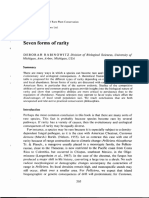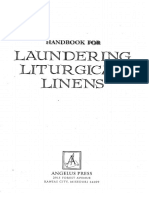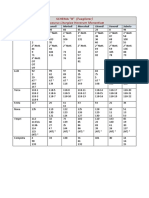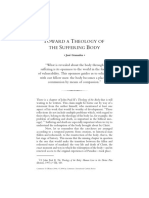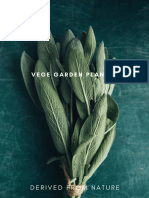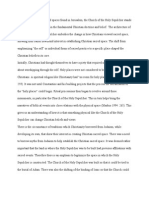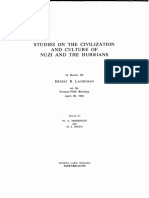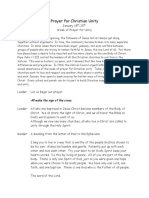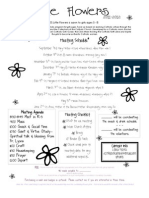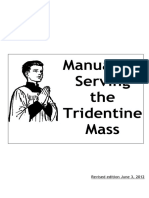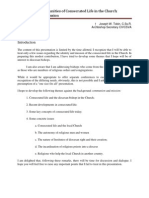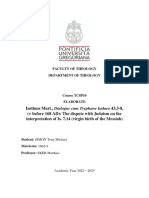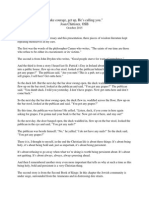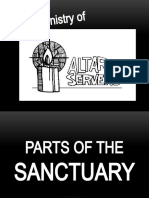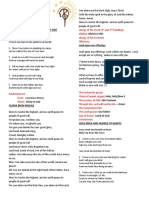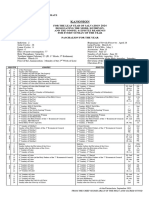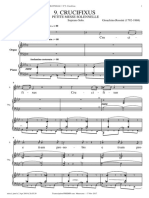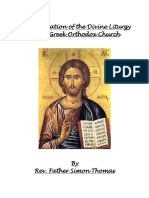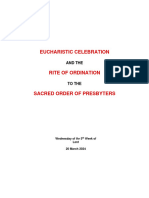i ni s t ry of
The M
�WELCOME BACK!
A. PARTS OF THE SANCTUARY
B. SACRED VESSELS
C. SACRED OBJECTS
D. SACRED BOOKS
E. SACRED GARMENTS
F. MOVEMENTS DURING MASS
�BASTA SAKRISTAN
MAGLILINGKOD
MAGPAKAILANPAMAN
�PARTS OF THE
SANCTUARY
� THE SANCTUARY
The Sanctuary is the space at the front of the church within
which most of the action of the Mass takes place. The word
means “holy place.” It is often set apart from the rest of the
church by being slightly elevated. There are many things in
the sanctuary with which you should be familiar.
� THE ALTAR
• The place where the Eucharistic Sacrifice takes place. The altar is
sacred and often contains relics of the saints. The place where the
Liturgy of the Eucharist takes place.
• The altar is sacred and often contains relics of the saints. Likewise,
either on the altar or near it, there should be a cross, with the figure of
Christ crucified, a cross clearly visible to the assembly, so as to call to
mind for the faithful the saving passion of the Lord.
• The Altar is the center of Thanksgiving that is accomplished through
the Eucharist.
• The celebration of the Eucharist in a sacred place is to take in the
Altar; however, outside a sacred place, it may take place on a suitable
table, always with the use of cloth, a corporal, a cross, and candles.
� THE AMBO OR LECTERN
• The Ambo is the stand at
which the Word of God is
read from the lectionary.
The homily is usually
delivered from the ambo
also.
• It is where the Liturgy of
the Word takes place.
� THE PRESIDENTIAL CHAIR
• The chair from which
priests lead the prayers
and rites of the church.
The adjacent chairs
are for deacons or
concelebrants.
� THE CATHEDRA
• The cathedra is also known as
the “Bishop’s Chair”
• The throne of the Bishop in his
cathedral
• It is an official and functional chair
for teaching; the importance of it
can be seen in the fact that it
gave the name to the church:
Cathedral
�THE TABERNACLE
The Tabernacle is the ornate place where the Eucharist is
reserved, and is kept locked with the Tabernacle key. If the
entire Church is “God’s House,” then the Tabernacle is
“Jesus’ Room.” Hosts are taken from and returned to the
Tabernacle at Communion time.
�THE SANCTUARY LAMP
The Sanctuary Lamp or Vigil
Candle is a candle in a red
holder that is lit when the
Blessed Sacrament is present
within the Tabernacle.
Proper reverence by genuflection
is to be given to the Tabernacle
at all times the vigil light is lit.
� THE CREDENCE TABLE
• The Credence Table is the side table near the sanctuary
where items are kept when they are needed for Mass
but are not currently being used.
�THE DIFFERENT
LITURGICAL
BOOKS
� The LITURGICAL BOOKS
Sacramentary
Contains the opening prayer, prayer over the gifts,
prayer after communion, and solemn blessings.
Eucharistic prayers and prefaces for all of the
masses including most special occasions.
� The LITURGICAL BOOKS
Lectionary
• Contains the scripture readings for Mass. It is
carried in the procession by the lector and
placed on the ambo.
� The LITURGICAL BOOKS
Book of Gospels
• This book contains the Gospel readings. It is
usually carried in the entrance procession by the
deacon or lector.
�THE DIFFERENT
SACRED
VESTMENTS
� Sacred Vestments
ALB
• This long, white, vestment reaching
to the ankles and is worn when
celebrating Mass. Its name comes
from the Latin ‘albus’ meaning
‘white.’ This garment symbolises
purity of heart. Worn by priest,
deacon and in many places by the
altar servers. The full white
garment worn by the priest,
deacon, and in some cases the
altar servers. The alb is symbolic of
Baptism.
� Sacred Vestments
CASSOCK
• A long garment worn by Altar
Servers (red) under the Surplice.
Also worn by Diocesan Priests
(Black), Monsignors (Rose),
Bishops (Violet), Cardinals (Red),
and the Pope (White).
• A long tunic-like garment which
reaches from the neck to the
heels and is worn by some
servers and clergy.
� Sacred Vestments
CINCTURE
• Cincture (optional)
• This is a long cord used for
fastening some albs at the waist.
• It is worn over the alb by those
who wear an alb.
• It is a symbol of chastity. It is
usually white in colour
� Sacred Vestments
CHASUBLE
• The chasuble is the sleeveless
outer vestment, slipped over the
head, hanging down from the
shoulders and covering the stole
and alb. It is the proper Mass
vestment of the priest and its color
varies according to the feast. It is
worn as a mantle over his
shoulders symbolizing the yoke of
Christ and signifies charity.
� Sacred Vestments
STOLE
• A stole is a long cloth, often
ornately decorated, of the same
color and style as the chasuble. A
stole traditionally stands for the
power of the priesthood and
symbolizes obedience. The priest
wears it around the neck, letting it
hang down the front.
• A deacon wears it over his right
shoulder and fastened at his left
side like a sash.
� Sacred Vestments
DALMATIC
• A loose-fitting robe with open
sides and wide sleeves worn by a
deacon on more solemn feasts. It
takes its color from the liturgical
feast as listed above.
� Sacred Vestments
SURPLICE
• This is a wide-sleeved garment,
slipped over the head, covering
the shoulders, and coming down
below the hips. It is worn over the
cassock.
� Sacred Vestments
COPE
• A cape-like garment which is put
over the shoulders and hangs to
the ankles, it is open in the front
and worn by a priest or deacon in
processions at Benediction and in
other services.
� Sacred Vestments
HUMERAL VEIL
• This is a long narrow shawl-like
vestment used at Benediction.
�THE DIFFERENT
SACRED
VESSELS
� Sacred Vessels
CHALICE
• This large cup is used at
Mass to hold the wine that
becomes the blood of Christ
� Sacred Vessels
PATEN
• This is a saucer-like dish that
usually sits on top of the
chalice. It holds the bread
that becomes the body of
Christ.
� Sacred Vessels
PALL
• This is a stiff square white
cover that is placed over the
chalice.
� Sacred Vessels
CIBORIUM
• The ciborium is a vessel
which contains the small
Hosts used for the
Communion of the faithful. It
can look like a chalice with a
large top and cover or a large
bowl with a cover.
� Sacred Vessels
CRUETS
• The ciborium is a vessel
which contains the small
Hosts used for the
Communion of the faithful. It
can look like a chalice with a
large top and cover or a large
bowl with a cover.
� Sacred Vessels
ASPERSORY and
ASPERGILLIUM
Aspersory is a container for holding
holy water. The Aspergillum, the holy
water sprinkler, is a stick-shaped
implement with holes in it to dip into
the Aspersory and catch the holy
water for sprinkling the people and
Things.
� Sacred Vessels
MONSTRANCE
• This is a large ornate vessel
used to hold the Blessed
Sacrament for Benediction
and Eucharistic processions.
� Sacred Vessels
LUNETTE
• A thin, circular receptacle,
having a glass face that holds
the Consecrated Host used at
Benediction
� Sacred Vessels
PYX
• A small metallic case for the
Holy Viaticum or for the
communion of the Sick.
� Sacred Vessels
THURIBLE
• This is used to contain the
burning charcoal on which
incense is put. Incense has
always been used since
early times to do honor to
people and things. For this
reason we incense the altar,
Book of the Gospels, bread
and wine, and the people at
Mass
� Sacred Vessels
Lavabo Bowl
• This is used to contain the
burning charcoal on which
incense is put. Incense has
always been used since
early times to do honor to
people and things. For this
reason we incense the altar,
Book of the Gospels, bread
and wine, and the people at
Mass
�THE DIFFERENT
SACRED
LINENS
� Sacred Linens
Purificator
• A folded piece of linen used
to purify or cleanse the
chalice. It is usually placed
on the altar.
� Sacred Linens
Corporal
• This comes from the Latin
‘corpus’ meaning a ‘body’. It
is a square of linen cloth on
which the vessels
containing the hosts and
the chalice are placed at
Mass
� Sacred Linens
Finger Towel
• Used by the priest to dry his
fingers
� OTHER
SACRED
OBJECTS
� Other Objects
Processional Cross
• The Processional Cross is
the large cross that is carried in
by a server at the beginning of
Mass and is carried out at the
end of Mass
� Other Objects
Processional
Candles
• These two candles are carried
either side of the cross in the
entrance procession. They are
then used to flank the Gospel
when it is proclaimed.
�DIFFERENT
LITURGICAL
COLORS
� GREEN
This is the standard color for
Ordinary Time. It is meant to
represent the anticipation and
hope in the resurrection of Christ.
Green symbolizes the hope and
life of each new day.
� PURPLE
Worn during Lent and
Advent. It represents
penance, preparation and
sacrifice. It is also worn at
funerals because of its
connection to mourning.
� ROSE
Rose vestments and altar cloth
are only worn twice in the
liturgical year, during the THIRD
SUNDAY OF ADVENT and the
FOURTH SUNDAY OF LENT.
This color shows the joy and love
in Christ.
� RED
It is the symbolic of passion
and blood. It is worn during
feasts of the MARTYRS,
Good Friday, Palm Sunday
and the Pentecost.
� BLUE
Wearing of this color is
permitted only to some
Churches. They may be used
in shrines dedicated to Mary,
and can also be used during
the Feasts of Mary.
� WHITE OR GOLD
Worn during Christmas and Easter. They
symbolize the birth and resurrection of
Christ. Other celebrations using white
includes: Holy Thursday, Most Holy
Trinity, Feasts of our Lord (except His
passion), Marian Feast, Feasts of
Angels, Sacrament of Baptism,
Matrimony and Holy Orders.
�POSTURES
DURING
MASS
� Posture at Mass
Posture is how you are using the parts of
your body at a particular time. An altar
server has to carry out a number of
different actions at mass, and so there are a
number of different postures. Know what
you are to do while serving, and when you
are to do it. Always do things smoothly.
If you make a mistake, never get flustered.
� Posture at Mass
Hands – Unless you are sitting down or
carrying something (like a candle), your
hands should be kept joined in front of your
chest; either locked together, or palm-to-
palm, fingers pointing upward. Keep your
hands high up on your chest. If you are
carrying something in one hand hold the
other hand flat on your chest.
� Posture at Mass
Bowing – When you bow to someone
or something at mass, it should be a
smooth forward inclining of your head
and shoulders. Never walk and bow at
the same time: stop before bowing.
There are two types of bowing, the
bow of the head and the bow of the
body as described below:
� Posture at Mass
Bow – This bow is a slow nod of the head, made
when: The name of Jesus is mentioned Leaving
the priest after an action (i.e. water and wine etc)
Profound Bow – This bow is made from the
waist with hands folded. It should be made
slowly and reverently when: Crossing the altar if
the Blessed Sacrament is not present At the
moment of elevation during consecration. During
the Creed at the words “by the power of the Holy
Spirit, He was born
of the Virgin Mary and became man.”
� Posture at Mass
Genuflecting – When you genuflect,
keep your hands in front of your chest
while you go down on your right knee.
Keep your body straight, bow your
head briefly, and rise to the standing
position. Be sure that your cassock/alb
does not trip you on the way down or
up.
� Posture at Mass
As a rule, if the Blessed Sacrament is
reposed in the Tabernacle, a
genuflection is made before and after
Mass, and outside of mass whenever
passing in front of the Tabernacle.
Exception: The cross-bearer when
carrying the processional cross does
not genuflect.
� Posture at Mass
Walking – Always walk with your back
straight and your head held straight
and high. The pace should not be
rushed but deliberate. The cross-
bearer always sets the pace in
processions. When walking in pairs, act
in unison, remember you are a team.
� Posture at Mass
Kneeling – When you kneel, your body
should be upright and your hands should
be in front of your chest, well above your
waist.
Standing – Always stand up straight with
both feet firmly on the floor six to eight
inches apart. This will give you balance
and comfort at the same time. Do not lean
against the furniture or against the walls.
� Posture at Mass
Sitting – Sit down on your chair carefully and gracefully.
Once you are seated, sit tall and do
not slouch. Place both feet firmly on the floor. Place your
hands on your lap or flat on your
thighs in a relaxed manner.
Eyes – During Mass always look towards the place where
the action is happening: the
celebrant’s chair, the ambo or the altar. When a reader is
reading the scriptures, you should
be looking at the reader. Keep your attention on the
presider in case he is need of your
assistance.
� i ni s t ry of
The M



